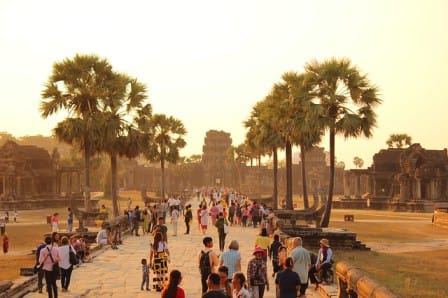Summary of “An Eastern Journey” by W.S. Maugham
“An Eastern Journey” is W. Somerset Maugham’s personal travel account of his visit to Angkor Wat, a magnificent Buddhist temple in Cambodia. He describes his difficult journey to the temple, which includes a three-day boat ride from Phnom Penh. Upon arriving, he is overwhelmed by the temple’s grand and mysterious beauty, which appears gigantic and black under the moonlight.
Maugham struggles with the challenge of describing the temple’s breathtaking appearance in words. He reflects on different literary styles, referencing authors like Ruskin, Walter Pater, and Sir Thomas Browne, but ultimately decides to keep his writing simple and direct.
During his visit, he reads “Travels in Indo-China” by Henri Mouhot, a French naturalist who was one of the first Europeans to document Angkor Wat. However, Maugham believes that Mouhot’s descriptions fail to capture the true grandeur and emotional depth of the temple ruins.
Maugham also observes nature’s power over human creations. The temple, once a mighty monument, is now partially hidden by jungle, moss, and lichen, as nature reclaims what man built. A violent storm at night reinforces his belief that nature is the greatest force, even more powerful than the gods worshipped in the temples.
He describes the ruins in different lights, noting that the rising sun enhances the intricate carvings, while the setting sun gives the temple an ethereal, melancholic glow. His journey ends with a visit to the Bayon Temple, where he experiences an unearthly silence that fills him with awe and reverence.
Ultimately, Maugham concludes that the most impressive monument is not the temple itself but human endurance and civilization, which have persisted for thousands of years.
Long Summary of “An Eastern Journey” by W.S. Maugham
“An Eastern Journey” is a personal travelogue by W. Somerset Maugham, in which he records his experiences and reflections during his visit to Angkor Wat, the famous Buddhist temple in Cambodia. The narrative captures his admiration for the ancient ruins, his struggle to describe their magnificence, and his thoughts on the passage of time, nature’s power, and the cultural and historical significance of the site.
The Journey to Angkor Wat
Maugham begins by describing the difficult and complex journey to Angkor Wat. His trip involves multiple stages, including a three-day boat journey from Phnom Penh, Cambodia’s capital. As he approaches the temple, he first sees the great towers of Angkor Wat, which appear gigantic and black in the moonlight, filling him with awe and wonder.

However, upon reaching the ruins, he faces another challenge: how to express the grandeur of Angkor Wat in words. The sheer magnificence of the temple overwhelms him, making him feel that no words can do justice to its beauty. This leads him to reflect on the difficulties of writing and the limitations of language in capturing emotions and sights.
Struggles with Writing and Literary Style
Maugham contemplates different literary styles and the best way to describe Angkor Wat. He mentions famous writers such as John Ruskin, Walter Pater, and Sir Thomas Browne, all known for their elaborate and artistic prose. However, he ultimately decides that a simple and clear writing style—as “plain and old as a telegram”—is more effective. He believes that excessively poetic or ornate descriptions would fail to convey the true emotional impact of the temple.
Henri Mouhot and Angkor Wat’s Historical Significance
While at Angkor Wat, Maugham reads “Travels in Indo-China” by Henri Mouhot, a French naturalist who was one of the first Europeans to document the ruins. Mouhot’s writings provide an early Western perspective on Angkor Wat. However, Maugham criticizes Mouhot’s descriptions, feeling that they are too factual and fail to capture the emotional and spiritual essence of the temple. He believes that Angkor Wat is more than just an architectural wonder; it is a monument full of history, spirituality, and human effort, aspects that Mouhot’s account does not fully explore.
Nature’s Power Over Human Creations
One of the key themes in Maugham’s account is the power of nature. As he explores the ruins, he sees how the jungle has reclaimed much of Angkor Wat. The once-majestic structures are now covered in moss, lichen, and tangled roots, showing how nature slowly overcomes human civilization.
This theme is reinforced by a violent thunderstorm that occurs one evening during his visit. As lightning flashes across the sky, the temple appears small and insignificant compared to the vast, uncontrollable forces of nature. Maugham reflects on why people created gods and temples, concluding that while human beings worship divine powers, nature itself is the most powerful force of all.
The Changing Beauty of Angkor Wat
Maugham describes how Angkor Wat’s beauty changes throughout the day. During sunrise, the golden light illuminates the intricate carvings and sculptures, enhancing the temple’s mystical charm. At sunset, the temple appears more melancholic, bathed in a soft, fading glow that gives it a timeless, otherworldly quality.
He also visits the Bayon Temple, another part of the Angkor complex. Unlike the symmetrical and grand Angkor Wat, Bayon feels strange and eerie. The silence of the place fills Maugham with awe and reverence, making him reflect on the mysteries of ancient civilizations and the passage of time.
Final Reflections on Angkor and Human Civilization
As his journey comes to an end, Maugham reflects on the cultural heritage of Cambodia. He observes a traditional Cambodian dance, which he finds deeply meaningful, as it seems to be the same art that was engraved in the temple carvings centuries ago. This continuity of tradition reinforces his belief in the resilience of human culture.
In his final thoughts, Maugham makes an important conclusion: the greatest and most awe-inspiring monument is not Angkor Wat or any other ancient structure, but humanity itself. He believes that human civilization, with its traditions and endurance, is far older and more remarkable than even the grandest temples. He states that in the East, “the most impressive monument of antiquity is neither temple nor citadel, nor great wall, but man himself.”
Conclusion
“An Eastern Journey” is more than just a travelogue—it is a deep reflection on history, nature, art, and human civilization. Maugham’s visit to Angkor Wat makes him realize the transience of human creations, the enduring power of nature, and the rich cultural legacy of the East. His observations highlight how human effort, belief, and creativity persist through time, making people and their traditions the true wonders of history.
Important Questions from Eastern Journey
Here are some important long-answer questions based on An Eastern Journey by W. Somerset Maugham:
- Why does W. Somerset Maugham find it difficult to describe the beauty of Angkor Wat? How does he resolve this challenge?
Answer:
Maugham struggles to describe the magnificence of Angkor Wat because its sheer grandeur and emotional impact cannot be easily captured in words. He acknowledges the limitations of language and reflects on how great writers like John Ruskin, Walter Pater, and Sir Thomas Browne have attempted to describe beauty with intricate details and elaborate prose. However, he realizes that overly poetic or complex descriptions might fail to convey the true essence of the temple. Instead, he chooses a simple and clear writing style, stating that writing should be as “plain and old as a telegram.” Through this approach, he hopes to communicate the emotional and spiritual impact of the temple rather than just its physical beauty.
- How does Maugham contrast human civilization with the power of nature in his description of Angkor Wat?
Answer:
Maugham portrays nature as a powerful and unstoppable force that ultimately reclaims human creations. As he explores Angkor Wat, he observes how trees, moss, and lichen have overtaken the ruins, showing how nature slowly erases the work of past civilizations. He also describes a thunderstorm, during which the temple appears small and powerless compared to the immense power of nature. Through these observations, Maugham suggests that while human beings create magnificent structures and worship gods, nature itself is the most powerful force of all. He highlights the transience of human civilization, emphasizing that even the greatest temples will eventually be overtaken by time and nature.
- How does Maugham evaluate Henri Mouhot’s account of Angkor Wat? Why does he believe it does not do justice to the temple’s grandeur?
Answer:
Henri Mouhot, a French naturalist and explorer, was one of the first Europeans to describe Angkor Wat in detail. Maugham acknowledges Mouhot’s contribution to introducing the site to the Western world, but he criticizes his account for being too factual and lacking emotional depth. Mouhot focuses on architectural details and historical context, but Maugham believes that Angkor Wat’s true magnificence lies in its spiritual and emotional impact, which cannot be fully captured through objective descriptions. According to Maugham, the temple is not just an archaeological site, but a place of deep cultural and historical significance, and Mouhot’s straightforward narrative fails to convey this deeper meaning.
- How does Maugham describe the changing beauty of Angkor Wat at different times of the day?
Answer:
Maugham vividly captures how Angkor Wat’s beauty transforms under different lighting conditions. During sunrise, the first rays of sunlight illuminate the intricate carvings and sculptures, creating an almost magical effect. The temple appears to come alive as the light highlights its fine details. In contrast, during sunset, the atmosphere changes—the temple is bathed in a soft, golden glow, creating a more melancholic and mystical effect. Maugham describes this as a moment of transition, where time itself seems to stand still, reinforcing the temple’s timelessness. By focusing on these changing moments, he highlights the dynamic and ever-evolving nature of beauty at Angkor Wat.
- What are Maugham’s reflections on the Bayon Temple, and how does it differ from Angkor Wat?
Answer:
Unlike the symmetrical and grand design of Angkor Wat, the Bayon Temple feels strange, mysterious, and eerie. Maugham notes that Bayon lacks the uniformity of Angkor Wat, making it appear more chaotic and enigmatic. He describes the unearthly silence that fills the temple, which makes him feel both awe and reverence. While Angkor Wat represents grandeur and artistic perfection, Bayon seems to embody mystery and the unknown, creating a stark contrast. This difference in architectural style and atmosphere leads Maugham to contemplate the varied expressions of human civilization and how different cultures have left their mark on history.
- How does Maugham connect traditional Cambodian dance to the artistic heritage of Angkor Wat?
Answer:
Maugham observes a traditional Cambodian dance during his visit and is struck by its grace and divinity. He notices that the dance closely resembles the carved figures on the temple walls, suggesting that Cambodian culture has preserved its artistic heritage for centuries. The movements, gestures, and expressions of the dancers appear timeless, reinforcing the idea that art and tradition continue to live on, even as civilizations rise and fall. This realization leads Maugham to his final conclusion: while temples and monuments may decay, human culture and tradition are the true lasting monuments of history.
- What final conclusions does Maugham draw about human civilization and history after visiting Angkor Wat?
Answer:
As Maugham prepares to leave Angkor Wat, he reflects on the impermanence of human creations. He realizes that while temples, cities, and empires rise and fall, human culture and traditions persist. He states that in the East, “the most impressive monument of antiquity is neither temple nor citadel, nor great wall, but man himself.” This means that the true legacy of any civilization is not its architecture, but its people—their traditions, beliefs, and way of life. Through this conclusion, Maugham suggests that human resilience, creativity, and cultural heritage are the most enduring aspects of history.

